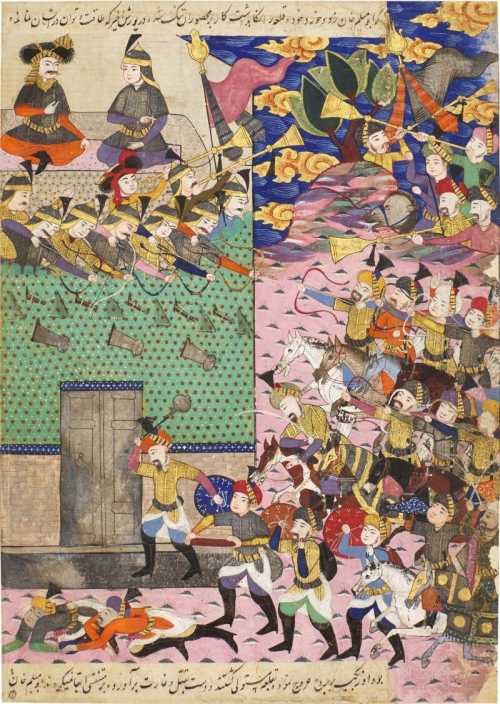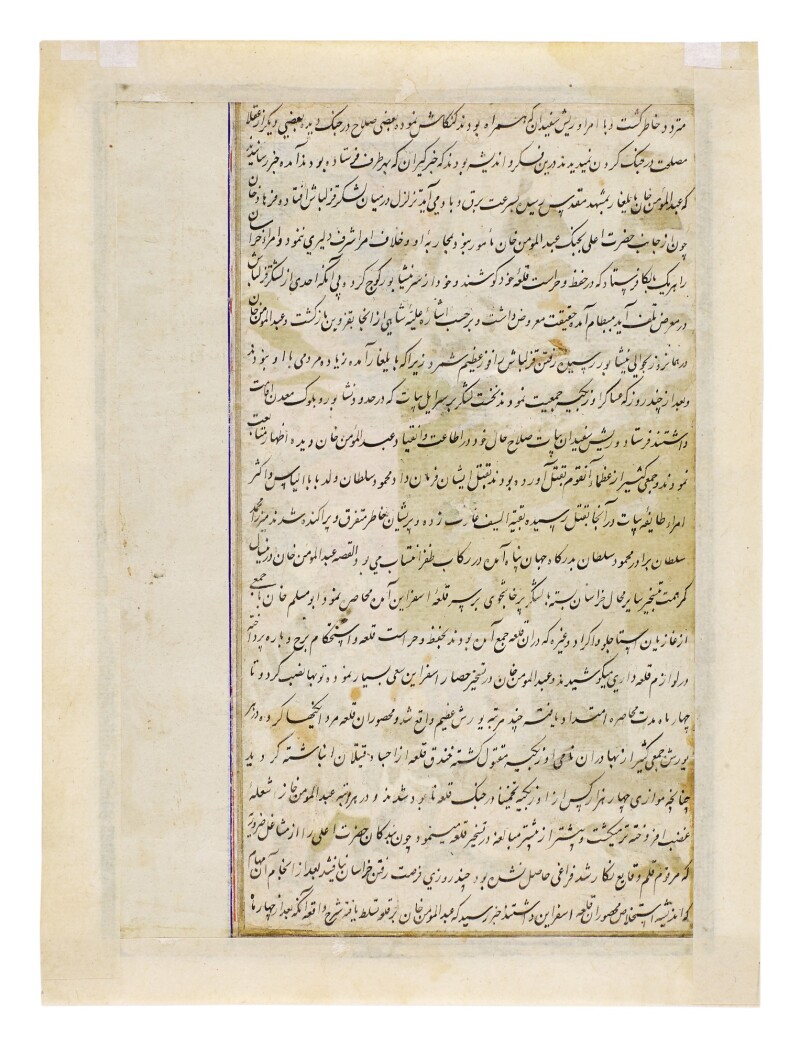- An illustrated and illuminated leaf from the Tarikh-i 'alam-ara-yi Abbasi of Iskander Bayg Munshi: the Uzbek army storms the fort of Isfarain, Persia, Isfahan, Safavid, circa 1650 1650
- Handicrafts and classics, Calligraphy, manuscript
- 19.5 * 26.5 cm
- gouache heightened with gold and silver on paper, a line of text to upper right and lower right in black nasta'liq script, with a narrow gold border and black rules, the reverse with 21 lines of text in black nasta'liq scriptpainting: 23 by 16.2cm.leaf: 26.5 by 19.5cm.
Estimation
£15,000
19,634 USD
-
£25,000
32,723 USD
Realized Price
£20,160
26,387 USD
0.8%
Artwork Description
This illustrated leaf originates from a rare illustrated manuscript of the Tarikh-i 'alam-ara-yi 'Abbasi, the history of Shah 'Abbas by Iskandar Munshi. Few examples survive from such a manuscript, as unlike the Mughals and Ottomans, the Safavids tended not to produce lavish manuscripts of their own reigns and histories.
Abdullah Khan II (r.1583-98) was the last ruler of the Shaybanid dynasty of Uzbekistan and ‘Abd al-Mu’min Khan was his only son. The text of the Tarikh-i 'alam-ara-yi 'Abbasi narrates ‘Abd al-Mu’min Khan’s plans to take over the fortress of Isfarain in the neighbourhood of Balkh. The Safavid governor, ‘Abu Muslim Khan, assembled a small army of soldiers which included Kurds and members of the Turkoman Ustajlu tribe. The Safavid army valiantly battled the Uzbeks over a period of four months before being vanquished. In the present work, ‘Abu Muslim Khan is depicted seated at upper left, wearing a large, elaborate headdress which is typical of the period of Shah ‘Abbas. The Uzbek soldiers are wearing turbans with distinct Turkic features compared to the Persian soldiers who are in helmets.
The leaf belongs to a group of paintings produced in Isfahan during the first half of the seventeenth century, some of which were previously thought to be Ottoman (see, for example, a group of leaves from a Timurnama of Hatifi in Binney, 1973, pp.126-7, nos.48a and b). Another similar illustration is in the Hermitage Museum, St. Petersburg, from a manuscript of the Akhlaq-i Muhsini, dated 1640 (see Petrosian (ed.), 1994, no.46).
Iskander Bayg Munshi chronicled the reign of Shah 'Abbas, completing it in 1628-29. Many of the events described in the history he witnessed himself, in his post as a secretary in the royal chancellery. Another illustrated leaf from this manuscript, formerly in the collection of the Marquis Avati, sold in these rooms, 19 October 2016, lot 190.
More lots by Unknown Artist
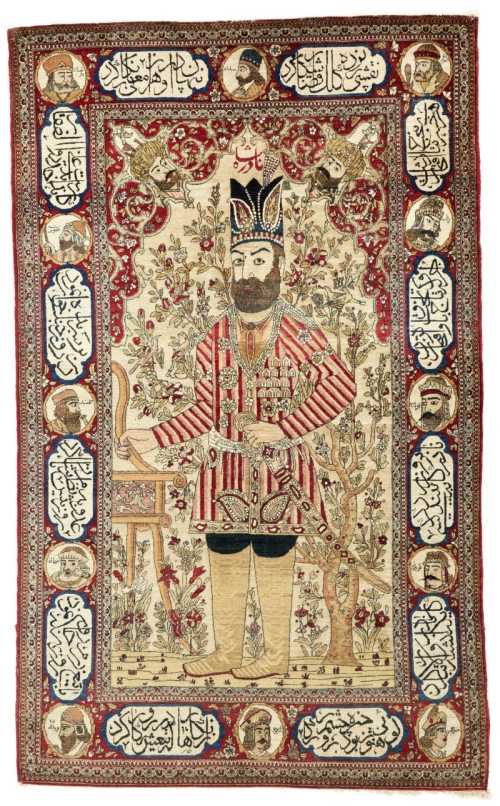
An Isfahan pictorial rug, Central Persia, circa 1910
Estimation
£4,000
5,236 USD
-
£6,000
7,853 USD
Realized Price
£5,670
7,421 USD
13.4%
Sale Date
Sotheby's
-
30 March 2022

A gold medal commemorating the coronation of Muhammad Reza Shah and Queen Farah
Estimation
£100
132 USD
-
£200
263 USD
Realized Price
£160
211 USD
6.667%
Sell at
Sale Date
Rosebery's Auction
-
1 April 2022
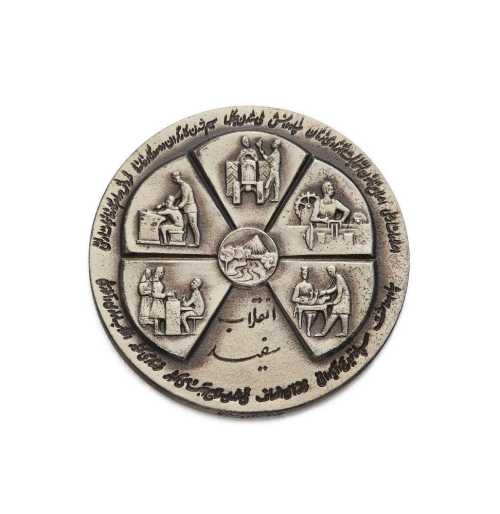
A silver memorial medal of the White Revolution, Muhammad Reza Shah, 1967
Estimation
£200
263 USD
-
£300
395 USD
Realized Price
£170
224 USD
32%
Sell at
Sale Date
Rosebery's Auction
-
1 April 2022
Realized Price
67,245 USD
Min Estimate
35,481 USD
Max Estimate
53,247 USD
Average Artwork Worth
+83.63%
Average Growth of Artwork Worth
Sales Performance Against Estimates
Average & Median Sold Lot Value
2021 - 2025
Performance vs. Estimate
2021 - 2025
Sell-through Rate
2021 - 2025
Similar Artworks
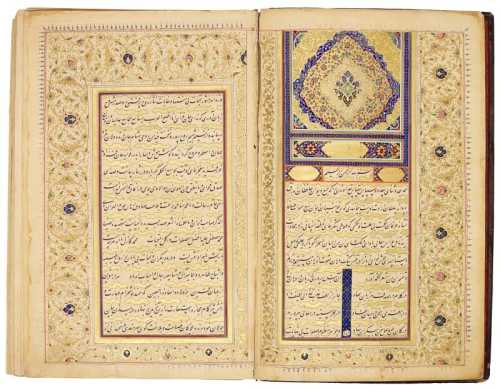
Hafiz (d.1390), Diwan, commissioned by Muhammad Ja’far Khan, copied by Fath'ali al-Shirazi, pen-named Hijab, in the Dar al-‘Ilm, Shiraz, Qajar Persia, dated 1267 AH/1850-51 AD.
Estimation
£6,000
7,853 USD
-
£8,000
10,471 USD
Realized Price
£18,900
24,738 USD
170%
Sale Date
Sotheby's
-
30 March 2022
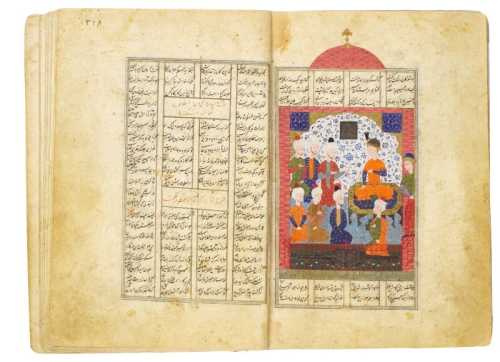
Nizami (d.1209), Khamsa, copied by Khwaja Mir ibn Shams al-Din Muhammad Munshi Astarabadi, Persia, Safavid, dated 966 AH/1558-9 AD
Estimation
£10,000
13,089 USD
-
£15,000
19,634 USD
Realized Price
£22,680
29,686 USD
81.44%
Sale Date
Sotheby's
-
30 March 2022
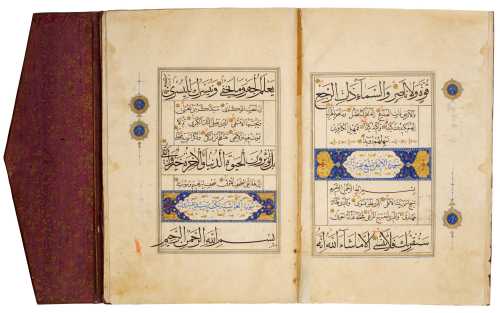
An illuminated Qur’an juz’ (XXX), copied by Muhammad ibn Hasan, known as Kamal, Persia, Safavid, dated 930 AH/1523-24 AD
Estimation
£15,000
19,634 USD
-
£20,000
26,178 USD
Realized Price
£18,900
24,738 USD
8%
Sale Date
Sotheby's
-
30 March 2022
